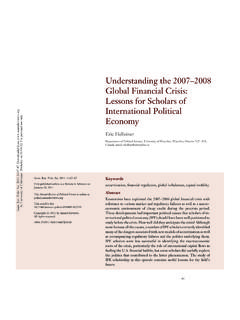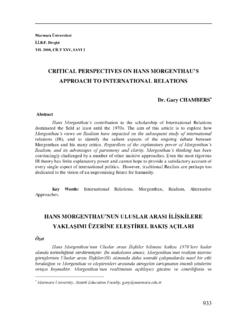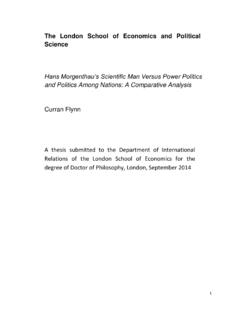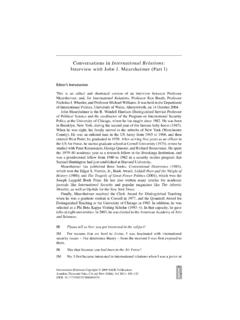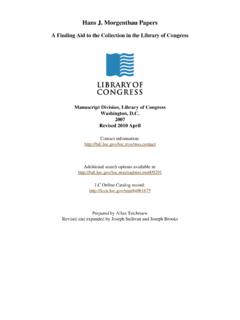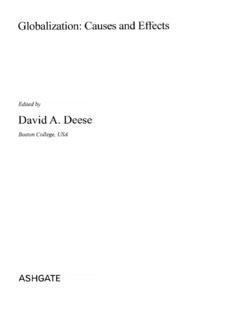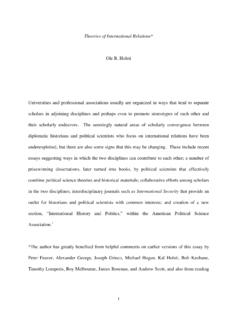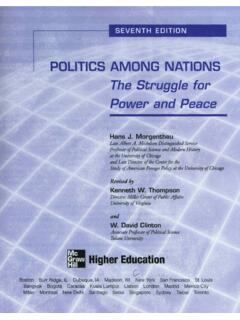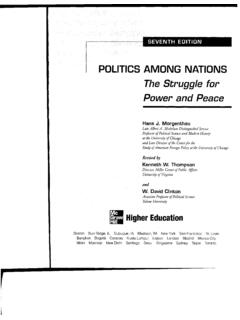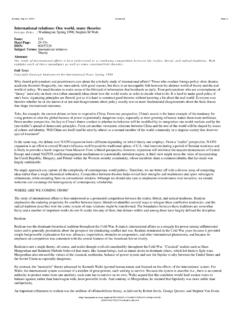Transcription of Mearsheimer’s World— Glenn H. Snyder Offensive Realism …
1 John J. Mearsheimer,The Tragedy ofGreat Power Norton, than fty yearshave passed since Hans Morgenthau introduced Realism as an approach tothe study of international relations. Since then, the approach has withstood notonly a steady assault from such external quarters as liberal institutionalism,the democratic peace school, and constructivism but also a marked divisivetendency. Splinter groups have emerged, each waving an identifying adjectiveto herald some new variant or emphasis. The rst of these came in the late1970s, when Kenneth Waltz s neorealism marked a major split from Mor-genthau s traditional Realism , which henceforth became known as classical then, especially during the last decade, new variants and newtags have proliferated. The eld of international relations now has at least twovarieties of structural Realism , 2probably three kinds of Offensive Realism , 3 Mearsheimer s World Offensive Realism andthe Struggle for SecurityGlenn H. SnyderA Review EssayInternational Security,Vol.
2 27, No. 1 (Summer 2002), pp. 149 173 2002 by the President and Fellows of Harvard College and the Massachusetts Institute of H. Snyder is Professor Emeritus of Political Science at the University of North Carolina, Chapel author wishes to thank Robert Jervis, Eric Mlyn, and Kenneth Waltz for their helpful com-ments on an earlier draft of this review Kenneth N. Waltz,Theory of International politics (Reading, Mass.: Addison-Wesley, 1979); andHans J. Morgenthau, politics among nations : The Struggle for Power and Peace(New York: Alfred , 1948 and later editions). Other traditional (classical) realist works are Carr,The TwentyYears Crisis, 1919 1939(London: Macmillan, 1946); Reinhold Niebuhr,Moral Man and Immoral Soci-ety: A Study in Ethics and politics (New York: Scribner s, 1932); Nicholas Spykman,America s Strat-egy in World politics : The United States and the Balance of Power(New York: Harcourt Brace, 1942);and Arnold Wolfers,Discord and Collaboration: Essays on International politics (Baltimore, Md.)
3 : JohnsHopkins, 1962).2. The label structural is sometimes applied to Waltz s theory, but the English school, led byBarry Buzan, has claimed that label for its modi cation of Waltz. See Buzan, Charles Jones, andRichard Little,The Logic of Anarchy: Neorealism to Structural Realism (New York: Columbia Univer-sity Press, 1993). Waltz himself uses the two terms Examples of Offensive Realism include John J. Mearsheimer, Back to the Future: Instability inEurope after the Cold War, International Security,Vol. 15, No. 1 (Summer 1990), pp. 5 57; Eric , Beyond Victory: Offensive Realism and the Expansion of War Aims, Security Studies,Vol. 6,No. 4 (December 1997), pp. 1 49; Robert Gilpin,War and Change in World politics (Cambridge: Cam-bridge University Press, 1981); and Fareed Zakaria,From Wealth to Power: The Unusual Origins ofAmerica s World Role(Princeton, : Princeton University Press, 1998).and several types of defensive Realism , 4in addition to neoclassical, con-tingent, speci c, and generalist debate among partisans ofthese differing views has been vigorous.
4 It has also been helpful in clarifying if not resolving some of the issues involved. A prominent participant in thesedebates has been John Mearsheimer, under the banner of Offensive Realism . Henow offers readers a book-length statement of his views,The Tragedy of GreatPower s WorldThis volume has been eagerly awaited by many international relations schol-ars and comes with strong recommendations from those who have read it. Forexample, Samuel Huntington declares on the dust jacket that it ranks with,and in many respects supersedes, the works of Morgenthau and Waltz in thecore canon of the realist literature on international politics . I attempt in thisessay to assess to what extent, and in what respects, this encomium may bejusti ed. I compare Offensive Realism mainly to Waltz s theory, becauseMearsheimer himself casts Waltz as the leading defensive realist and his pri-mary target. I conclude that the book is a major theoretical advance. It does notInternational Security 27:1 1504.
5 Besides Waltz,Theory of International politics ,other examples of defensive Realism include RobertJervis, Cooperation under the Security Dilemma, World politics ,Vol. 30, No. 2 (January 1978),pp. 167 214; Sean M. Lynn-Jones, Realism and America s Rise: A Review Essay, International Se-curity,Vol. 23, No. 2 (Fall 1998), pp. 157 183; Jack Snyder ,Myths of Empire: Domestic politics and In-ternational Ambition(Ithaca, : Cornell University Press, 1991); Barry R. Posen,The Sources ofMilitary Doctrine: France, Britain, and Germany between the World Wars(Ithaca, : Cornell Univer-sity Press, 1984); Stephen Van Evera,Causes of War: The Structure of Power and the Roots of War(Ithaca, : Cornell University Press, 1999); and Stephen M. Walt,The Origins of Alliances(Ithaca, : Cornell University Press, 1991). For surveys of the various branches of Realism , see StephenG. Brooks, Dueling Realisms, International Organization,Vol. 51, No. 3 (Summer 1997), pp. 445 477; Colin Elman, Horses for Courses: WhyNotNeorealist Theories of Foreign Policy?
6 SecurityStudies,Vol. 6, No. 1 (Autumn 1996), pp. 7 53; Sean M. Lynn-Jones and Steven E. Miller, Preface, in Michael E. Brown, Lynn-Jones, and Miller, eds.,The Perils of Anarchy: Contemporary Realism andInternational Security(Cambridge, Mass.: MIT Press, 1995); Jeffrey W. Taliaferro, Security Seekingunder Anarchy: Defensive Realism Revisited, International Security,Vol. 25, No. 3 (Winter 2000/01), pp. 128 161; and Benjamin Frankel, Restating the Realist Case: An Introduction, SecurityStudies,Vol. 5, No. 3 (Spring 1996), pp. xiv xx. Jack Donnelly provides a trenchant critique inReal-ism and International Relations(Cambridge: Cambridge University Press, 2000). It could be arguedthat there are two cross-cutting dichotomies: classical Realism versus neorealism, and Offensive re-alism versus defensive Realism . From that perspective, Mearsheimer and Waltz are bothneorealists, the former Offensive , the latter Gideon Rose coined the term neoclassical Realism in Neoclassical Realism and Theories ofForeign Policy, World politics ,Vol.
7 51, No. 1 (October 1998), pp. 144 172. Charles L. Glaser callshimself a contingent realist in Realists as Optimists: Cooperation as Self-Help, International Se-curity,Vol. 19, No. 3 (Winter 1994/95), pp. 50 90. Richard Rosecrance proposes speci c and generalist strands of Realism in Has Realism Become Cost-Bene t Analysis? A Review Essay, International Security,Vol. 26, No. 2 (Fall 2001), pp. 132 John J. Mearsheimer,The Tragedy of Great Power politics (New York: Norton, 2001). Subse-quent references to this book appear parenthetically in the Waltz, but nicely complements him by introducing a theoretical ra-tionale for revisionist states. This provides a foundation for merging offensiveand defensive Realism into a single theory. Mearsheimer also offers strikingnew insights into balance-of-power theory, the role of geography, and the de-bate over land power versus air and naval power. The theory is tested and il-lustrated over two centuries of history and projected two decades into thetwenty- rst century.
8 These projections are provocative and pessimistic butstill plausible. The book s principal weakness is its overemphasis on powerand security maximization as motivations of states essay follows the organization of the book. It begins with a summaryand critique of the core of Offensive Realism , then moves to a discussion of thehistorical evidence bearing on the theory. Next, Mearsheimer s ideas aboutbalancing and buck-passing are criticized and related to broader concepts inalliance theory. After a brief look at his ndings on the causes of war, the essayconcludes with an analysis of his prescriptions for future foreign Core Theory: Mearsheimer versus WaltzMearsheimer begins with the assertion that great powers maximize their rela-tive power (p. 21). That puts him close to Morgenthau, who famously pro-claimed a never-ending struggle for power among states, arising from ananimus dominandi that is, a natural human urge to dominate , however, rejects this source of causation. There is a limitlesspower struggle, he avers, but what drives it is not an appetite for power in thehuman animal, but a search for security that is forced by the anarchic structureof the international system.
9 When all states have capabilities for doing eachother harm, each is driven to amass as much power as it can to be as secure aspossible against attack. This assumption of a security motivation and struc-tural causation, of course, places Mearsheimer closer to Waltz. WhereMearsheimer departs from Waltz is in his assertion that the search for powerand security is insatiable, whereas Waltz says that it has limits. Thus he dis-agrees with Waltz on the question of how much power states want. Mearsheimer makes the point succinctly: For defensive realists, the interna-tional structure provides states with little incentive to seek additional incre-ments of power; instead it pushes them to maintain the existing balance ofMearsheimer s World 1517. Morgenthau, politics among nations ,chap. Preserving power, rather than increasing it, is the main goal of realists, on the other hand, believe that status quo powers are rarelyfound in world politics , because the international system creates powerful in-centives for states to look for opportunities to gain power at the expense of ri-vals, and to take advantage of those situations when the bene ts outweigh thecosts.
10 A state s ultimate goal is to be the hegemon in the system (p. 21).Waltz con rms the disagreement: In anarchy, security is the highest if survival is assured can states safely seek such other goals as tranquil-lity, pro t and power. The rst concern of states is not to maximize power butto maintain their positions in the system. 8 Clearly, Waltz believes that sur-vival ( , suf cient security) can be assured with power well short of the he-gemonic amount postulated by notions of hegemon and potential hegemon are prominent inMearsheimer s theory. Global hegemony is virtually impossible, except for astate that has acquired clear-cut nuclear superiority, de ned as a capabilityto devastate its rivals without fear of retaliation (p. 145). Barring that unlikelydevelopment, hegemony can only be regional. A hegemon is the only greatpower in its system. Thus, if a region contains more than one great power,there is no hegemon. The United States is the only regional hegemon in mod-ern history, through its domination of the Western Hemisphere.
